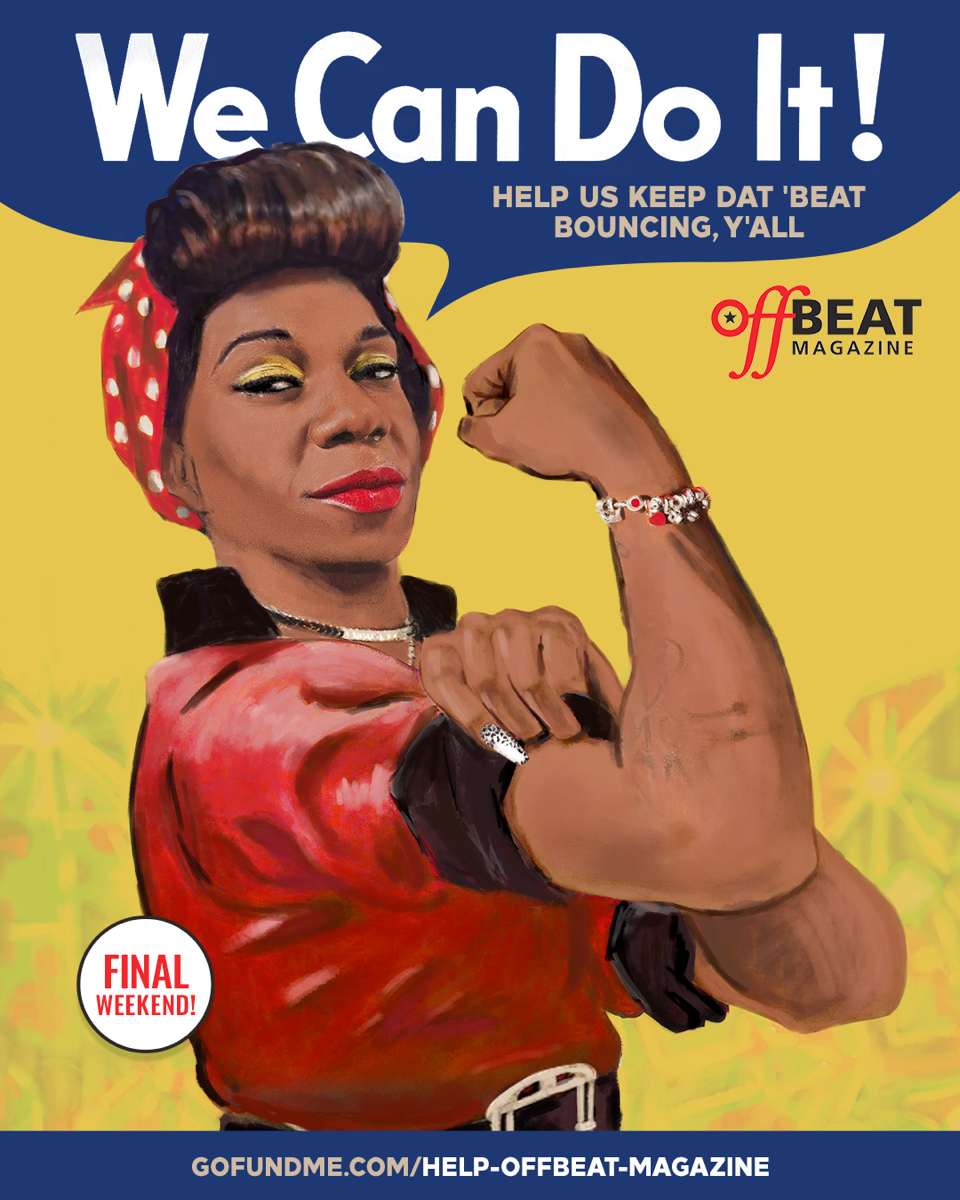Commissioned to create the painting that would grace OffBeat’s annual Jazz Fest issue, Cajun artist Earl Hebert wanted to give Antoine “Fats” Domino the regal treatment. Fats’ royal coiffure, a sort of modified flattop, presented an artistic dilemma: “I was going to try to put the crown on his head because he’s the King but his hairstyle is just so definite, I had to put the crown elsewhere.”
Hebert is a definite Cajun, “born in Ossun, a little ways north of Lafayette. I went to school in the Scott area, which is about five miles west of Lafayette. My father had the grocery store and ran the cotton gin. My grandfather, next door, had the old saloon/barber shop/gambling hall. I hung around him a lot. As a kid, you think that’s exciting—watching ’em gamble all weekend, three or four days at a time. And I’d help my grandmother make hamburgers so they’d stay and gamble.
“My brother and sister were really better at drawing than I was. I liked it more than they did and I stuck at it and continued playing with it. I studied at Southwestern for a couple of years—sculpture and art-related stuff but I never took any painting courses. Then I went into the grocery business for seven years and then I got into the restaurant business in Lafayette and I opened up a couple of places—a steakhouse and a bar, a ‘fern’ place.
“We were doing good and I decided to get some paint and start playing with paint as a hobby. I could always draw what I saw and after about five years of playing with paint, I stopped painting with oils and I started painting with acrylics. With the oils, I was doing realistic stuff, but then when I got into acrylics, I couldn’t blend ’em, they dried so quick. So I started doing the culture/folk art stuff, telling my Cajun stories, what I remembered and knew was different from other parts of the country. After I got out of high school, I went in the service and I realized how different we were. I never thought about it, growing up, because everybody spoke French and anybody that came around and spoke English was an ‘Américaine.’”
In 1989, Hebert migrated to New Orleans and started exhibiting his paintings at Jackson Square: “Before I came to New Orleans, I was just using earthy colors—siennas and stuff. When I came to New Orleans, I finally switched to just the primaries and now I just use the cadmium yellow, cadmium red and the phthalocyanine blue and I mix my colors from that.
“I’d go to the Square and they would buy ’em but they would say, ‘How can I frame this?’ So I started making the frames during the last part of ’95. I had two frames built and I finally got up enough nerve to paint something crazy on each side. The first Saturday I brought one of those paintings to the Square, I doubled the price—instead of $1,000, it sold for $2,000 with the frame. That night, I framed another painting and on the way to Jackson Square, these people were moving out of the Pontalba to Park City, Utah. The lady saw the frame on this zydeco painting and she said, ‘Oh, I have to have it!’ And so she bought it right there so I turned around and didn’t even go to the Square that day. I came back and started making frames. It seems like the frames are crazy enough and different enough to attract people’s attention to at least look at the paintings.
“I’m definitely not a guy who’s never read an art book. Everybody teaches themselves—you don’t really have to go to art school. I just enjoy what I enjoy. I try to pick out the humor in Cajun culture. They are happy paintings—people tell me that all the time.
“I don’t know what it is about the Cajun culture that’s made it so popular besides the music and the food. The people are just regular people. Being brought up in that culture I don’t really see it but people from other places say the Cajuns are just friendly people. They enjoy a good time. They need very little in life to pass a good time. During the Depression, my grandparents told me, they didn’t even really notice it was a Depression. They had all the seafood, all the garden vegetables they needed. Things still went on the same way.
“South Louisiana was so isolated with the Atchafalaya basin on one side and the Sabine River on the other. The Cajuns were left alone until World War II and the oil industry came. Before then, they had their own little culture. If they’d been wide open, they’d have everybody else’s culture mixed in. Cajuns have always enjoyed work and play. Education was not the most important thing—in my family anyway. To my grandparents, the most important thing was to enjoy life and be happy. Sometimes you lose track of that. You’re only here for a little while, you know. No matter how smart you are, you’re going to go to the same place.”
Before he gets to that Final Destination, Earl Hebert is determined to savor life’s jewels, including as much zydeco music and Cajun cuisine as possible. The late Clifton Chenier remains his favorite musician: “He was playing at Jay’s, which was only about a quarter-of-a-mile from where I grew up. They’d have cockfights in the back and a loser’s gumbo for the rosters that didn’t make it—they’d get thrown in the gumbo. And the band would eat the loser’s gumbo. Clifton is definitely the King of Zydeco as far as I’m concerned.”
Hebert’s favorite Cajun dish is an acquired taste: “Something I can’t even get my friends to eat—cow tongue. It’s delicious. It’s totally different and it sounds so awful that none of my friends want to eat it. First of all, you’ve got to boil it for a few hours and get all of that excess skin off of it. Nowadays, there’s a place in Scott—Best Stop—that does all that and they stuff it with garlic, onions and bell pepper. Then you cook it for about three hours—you keep turning it over and browning it. Then you slice it up and put it back in the black iron pot and cook it for another hour in its gravy. There’s no fat to it. It’s like a filet mignon and you can eat it with a fork. It’s that tender. It’s really tasty.”
To view the exceedingly tasty paintings and prints of Earl Hebert, visit his French Quarter gallery at 1034 Royal Street, or his beautiful web site, designed by his godson (Cajun musician Ward Lormand, a member of Filé): earlhebert.com.
GRAVE SITUATION
On Wednesday, May 2, at 1:30 p.m., the Friends of New Orleans Cemeteries will honor jazz master Isidore Barbarin with a second line, commencing at St. Augustine Church, 1210 Governor Nicholls Street, and ending at St. Louis Cemetery #1. At the festive event, the Friends will announce their plan to establish a tomb in St. Louis Cemetery #1 that will provide free burial for musicians. The tomb will be the historic Dieu Nous Protégé Society tomb, originally constructed by a benevolent association of free people of color.
HOG WILD
Tragedy is never far away in New Orleans, as exemplified by the recent accident in which an automobile crashed into the entrance of the Mother-In-Law Lounge, destroying the mural of founder Ernie K-Doe from, sadly, the waist down. To the rescue come the “original” Bush Hogs, direct from White Castle and Raceland, accompanied by the Piglettes, performing a benefit concert with all donations going to the Mother-In-Law Lounge Preservation Fund. The porcine proceedings take place at the Lounge on Friday, May 3. Attendees are urged to dress in pink. Oink!
FOUNTAIN OF YOUTH
Interviewed at home in Baton Rouge (“Reminds you of California, but much better food”), Clarence Fountain, leader of the Grammy-winning Five Blind Boys of Alabama, declares the Jazz & Heritage Festival as one of the gospel group’s favorite gigs: “I like to come to the Jazz Fest because you have people from all over the world and I mean, all over the world. We go to towns overseas and people come and say, ‘I heard you at the Jazz Fest.’ It’s a good thing.” What keeps Clarence youthful? “I like gumbo pretty good and I like blackened fish—red snapper.”
POMP ‘N’ STOMP
For certain, less-than-law-abiding citizens of this realm, the Ponderosa is not the television homestead of the Cartwrights but rather, a nickname for Angola State Penitentiary, the temporary home of many renowned local musicians. The first annual Ponderosa Stomp, to be held April 30 through May 2 at the Fine Arts Center (1733 Constantinople), will star a select assembly of these immortal musicians—at least the ones who aren’t in jail, including Hubert Sumlin, James Blood Ulmer, Herb Hardesty, Earl Palmer, Tony Joe White, James Burton, Dave Bartholomew, Ernest McLean, Earl King, Barbara Lynn and a cornucopia of others. Produced by OffBeat contributor Michael Hurtt and his personal anesthetist, Dr. Ike, the Stomp’s programming is approximately a zillion times more intriguing than anything happening at the Fair Grounds. Or, as the producers claim, the Stomp will be “so funky it will decapitate your head.” Ouch!



